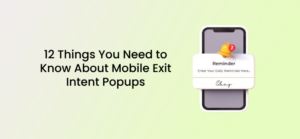Quite often in life we come to important insights precisely at moments when not everything is going smoothly. And like many important insights, the ones I will tell you about in this post have come in moments of reflection and deep thought about how to solve major problems, and in this case: how to increase sales significantly. I’ll begin with a painful story, about the moment in which I realized that in order to sell more, we must define structured sales processes, otherwise the chances of closing deals are reduced significantly. An important point worth mentioning – most of the insights in this post relate to sales processes that are B2B (meaning, business to business), mainly for services, and are not designed for sales processes intended for consumers or for enterprise companies, although I assume that some of the processes can also be applied in cases of enterprise companies.
A brief but important note: The processes described in this post are not related to our product Poptin, but to a digital agency which was the first business we established. The sales processes for Poptin are completely different since it is a SaaS product and not a service.
And now, back to our story!
It was the summer of 2010. My partner, Tomer, and I were in the beginning stages of our first business. As part of the many roles we took upon ourselves, the role of sales was extremely important. We were the sales people, the professional people who carried out the core work, the bookkeepers, the administrative managers, and also the dish washers of our company 🙂

It was our first business, and since we were involved in many other aspects of the business, we didn’t put too much thought into the sales process and we took it quite light-heartedly (an attitude which changed very quickly). We had a script prepared for a sales call, but our approach was “do your best during the call and hope for the best”. We noticed that we did in fact close deals, but that happened only when during the first call there was good chemistry with the client. In other cases, the chances of closing a deal were very slim. Since we were also in charge of our accounting, we soon realized that a young business must sell in order to grow and develop. At this stage, we made a shift in our approach and instead of focusing on clients with whom we managed to close a deal, we focused on the attempt to understand why we failed in closing with others. We couldn’t get out of our heads the clients who contacted us, but with whom we didn’t manage to close a deal.
So, what were the main problems? Let’s try to look at it from the client’s point of view. The client was looking for the service we offered, and found our company. After making some internal checks, the client decided that we seem good enough in order to call us or to leave their contact info on our website. What happens next? The client makes contact in one of those ways, and finally gets to have a conversation with one of us. During the conversation, he receives relevant details and ends the call. After the call (and maybe beforehand), he speaks with other companies which offer the exact same service. At this point, he already has a bit of a “mush” in his head, and he has a lot to think about. He reaches a point where he must make some decisions and understand exactly what his needs are. By this point, the client has probably forgotten the exact name of our company and with whom he had spoken. He remembers something vague but not the specifics. Meanwhile, during the evening he gets two price proposals from the competing companies. Two days later they call him to check the situation, answer questions that arose and continue the selling process. One of the companies had already arranged a meeting with him. He’s already forgotten about us; our call was mixed with other calls he had. What is currently on the client’s mind are the companies that continued the sales process with him, and he will probably close a deal with one of them.
What does the worst conceivable selling process look like? If I had to characterize the worst selling process, it would look like this: A business owner receives a phone call and answers the client freely and offhand, without relying on a pre-written sales-call script. The business owner ends the conversation with the client and that is also the end of the sales process. Perhaps a deal is made, perhaps not. Over the years, we had a client who worked the same way as I described, and even gave up on a contact form on his website because he didn’t have the energy to talk to clients who were proactively interested.

The sales process described above is wrong, because it is carried out under the assumption that the selling process is quick and should take one phone call to complete, while in practice, most sales processes take time and need some cultivation. Creating a set selling model will enable you to increase your sales significantly on the one hand, while continuing to improve the process and test new things that would help you grow your business.
The steps I am about to elaborate on, can be roughly divided into two major types: A part of those are operative measures that require actions on your part (for example: conducting a follow-up call once every X days), and the other part is comprised of steps which require a “psychological” understanding of the client’s perception and providing solutions to those needs that would enable you to move forward and close the deal. And of course, some of these steps contain the two types together, since they require an action on your part but they also meet a specific need of the client.
Now, let’s dive into the 9 steps you can add to your sales funnel in order to increase your sales cycle:
1. Form a sales-call script (but stay flexible)
Form a sales-call script
Don’t treat each sales call as a completely new process; it’s important that the messages you convey to your client will be based on your past experience in selling to other clients you’ve had. Many times, this happens naturally and the call script is built as if by itself, but the script would be better if you proactively devote time to its formulation. Once you start talking to clients, you start noticing certain things that are important to say, and even the right order in which to say them. You become aware of certain things that are said which create a positive response from clients. It is very important that you create a clear call script which addresses most of the client’s needs and provides explanation about them in a clear, easily understood manner. I also recommend that you write the script on paper and go through every single detail. For everything you say there must be a reason. From time to time you will improve the script based on insights that come up in conversations with clients.
And yet, even though you have a call script, it is important that you remain flexible and adapt the things you say to the client. Don’t ever switch to ‘autopilot’ during a sales call. Be responsive to what the client says.
Important: in this post, I will not refer to the content of the sales script, that would be in a separate post 🙂
2. Before calling a client, send a personal e-mail
This tip is relevant for communicating with clients who left their contact information and are waiting to receive your call (not for clients who called you directly). One way to create a personal experience for your client and to distinguish yourself from your competitors is to send a personal e-mail to the client before you talk to him. What should you include in your e-mail? It is important that you introduce yourself, let the client know that you have received his inquiry and that you will contact him soon to tell him more. You could ask him by e-mail when it is convenient for him to have the call, in order to avoid a situation where you call at an inconvenient time. It is important to include in the e-mail your signature and personal contact details. The advantage of this move is that it will make you more memorable to the client, and create a warmer personal relationship with the client.
Tip for Champions: you can automate the process with tools such as Zapier.
3. The first phone conversation with the client

Now is the time to pull out that call-script you prepared in advance. Remember, there is no second chance to make a first impression, so it’s important that you come to the first conversation as sharp as you can be. You should be in a quiet place, be focused and ready to give it everything you’ve got. Most of the important information you have, will be conveyed to the client in that first conversation. Work according to the script, but stay flexible. The important points to pay attention to during the conversation are: understand who your client is, why he approached you, what his past experience is in working with companies in your field, what his expectations are, etc. Along with obtaining information from the client, the purpose of the call is to convey to the client the information he needs in order to make a decision. At the end of the conversation, ask the client when he would like you to call again.
4. Always send a price proposal!
An ironclad rule (except in special cases), always make sure that the client receives a written price proposal by e-mail after the call has ended, and a short summary of the issues that came up in the conversation, preferably during the day you spoke with the client. Why is that important? The client won’t remember much from your conversation, in fact, the client will only remember a fraction of the things you tell him, and sending a price proposal enables you to set an anchor that will remind the client exactly what was said during the conversation, and what the price proposal is about. And if your price proposal will be well-designed and pleasant to look at, then that’s a great bonus!
5. Working with CRM – a Must
Perhaps the most important item on this entire list. CRM is a customer management system. In fact, it is a “brain” that is outside of your head, where all the information related to the client and to the dealings with the client is placed. You need to implement a standard practice into your work method – as soon as you finish speaking with your client, you must add the client to the CRM system. What are the key points to enter under each client? The name of the client, its field of activity, the date of the next communication to be made, a summary of agreements with the client, a link to the client’s website, the classification of the transaction, the potential of the sale and more. Try not to create too many CRM fields in order not to create a burden for you and an overload of unnecessary information. The CRM will ensure that your sales process is consistent.
6. The Golden Rule: Follow-up
Follow-up is the contact you keep with the client in order to check their situation. A follow-up will prevent you from falling into a one-time, wrongly done sales process (a process whereby you contact the client only once). As I mentioned earlier, the sales process is a gradual process rather than an immediate process. Therefore, a good follow-up will ensure that you track the client’s situation, give him a real-time response to his objections and close the deal. At the end of every follow-up you need to receive information from the client about the next time he wants to be contacted. Note: don’t just call the client every day because that would be futile. All you have to do is ask the client, and so you will know what the correct time intervals are for the follow-up call, to ensure that the next conversation with the client will be substantial.
7. Diversify Communication Channels (or: don’t limit yourself to one communication method)
A common mistake made by many business owners, is trying to contact their clients by one method which is convenient to them, instead of thinking of the means of communication that would be convenient to the client. For example, directing all communications with the client to communication by phone, even though the client may prefer a different kind of communication. In cases where you notice that the client is not comfortable speaking with you over the phone, you should check other channels, such as e-mail, WhatsApp, SMS, etc. Another advantage of diversifying communication channels is that once you switch to more personal communication means like WhatsApp, you increase the chances of getting positive response from the client. Keep in mind that if you don’t want to communicate with your clients through WhatsApp for one reason or another, of course there is no point in conducting the sales process through WhatsApp and then closing the option of communicating through WhatsApp later, after closing the deal.
8. Identify objections in time and provide answers
No matter what you do and who your clients are, there will always be objections on the part of the client that will obstruct them from closing the deal, and you must be familiar with all of these types of objections. Don’t try to sidestep objections; it might make it easier for you during the conversation, but the client will view it as a red flag that will stop them from closing a deal with you. A large part of the objections repeat, therefore it would be quite simple to form a list of recurring objections and prepare good answers. The objections may come in various shapes and sizes, such as objections to price, objections to the nature of service, objections that specifically concern your company and more. Objections can also be present due to a matter that doesn’t concern you in any way, for example in a case where the client is waiting for a third party to perform a certain service before they can move forward with you. It’s important to understand the nature of the objection before you provide an answer. For example, a client may object because your service is lacking a specific element which is important for him; there is no point in offering such a client a price discount since this is not what he is looking for, and it won’t advance you towards closing a deal.

9. Talk less, listen more
Contrary to what is commonly thought, when you ask people to describe a good salesman, they probably describe a classic salesman, his hair loaded with gel, standing in front of the client and telling him some magic phrases that bring about the closing of the deal, but reality is quite different. The best salesmen in the world hardly talk during the sales call. On the other hand, they listen a lot. Tell the client the basics, but before you continue, listen to the client and understand what problems he is trying to solve, what his past experience is, and what he expects to get from the company with which he will close the deal. The earlier you understand the client’s motives, the more you will be able to address those and raise your chances to have the client choose you.
10. Do you have clients who recommend your company? Tell the client about them
One of the most powerful selling tools is other clients who recommend your company. Even in cases where there is no objection on the part of the client, it’s important to mention your record and the fact that there are many other clients who recommend you and to whom you can refer if necessary. Consider adding client testimonials to your price proposal. Your clients are looking for any proof that you are really what you claim to be, and once there is a definite Social Proof, it will make it easier for the client to make the decision. No one wants to be the first customer of an inexperienced company. 🙂
What’s the next step?
Implementing all of the tips is not done in one day, in fact it is done throughout the lifetime of the business, but the more you focus on refining your sales process, the better results you will see in your sales cycle, and the good news is that the more you become aware of the process, the better it will get. As with many processes in your business, the sales process also requires repeated testing to get the best results. Always try new things until you find out what works best for you, because each business has its DNA and the unique methods that take it to the next level.
Do you have practical tips that can help improve the sales process? Share your comments!




